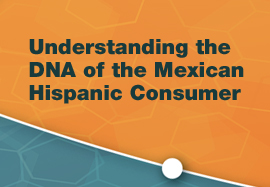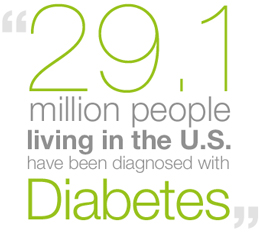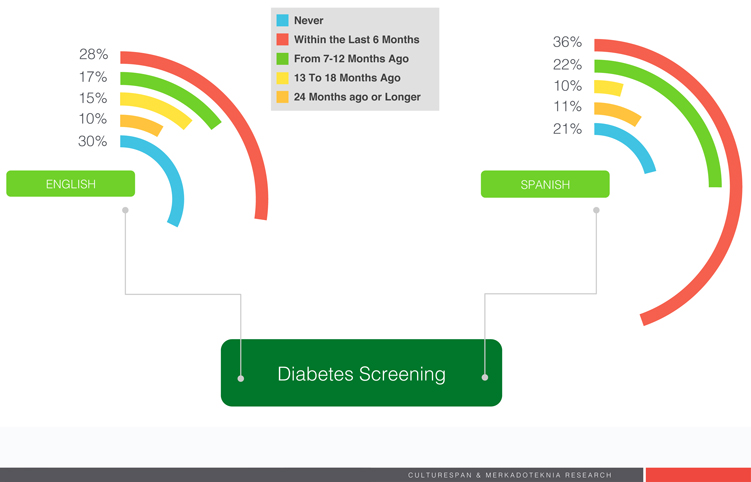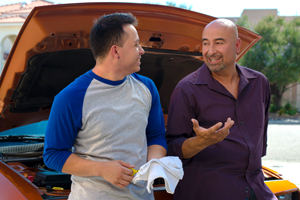Shifting Trends in Diabetes Testing Among Hispanic Millennials
 A few months ago I had the honor of delivering a talk at the statewide Multicultural Health Conference held in Minneapolis, Minnesota. The talk focused on the first data extraction from a consumer research study developed by CultureSpan Marketing in partnership with MerKadoTeknia Research and Consulting titled, “Understanding the DNA of the Mexican Hispanic Consumer: Decoding Attitudes and Beliefs Relating to Health-Seeking Behaviors.”
A few months ago I had the honor of delivering a talk at the statewide Multicultural Health Conference held in Minneapolis, Minnesota. The talk focused on the first data extraction from a consumer research study developed by CultureSpan Marketing in partnership with MerKadoTeknia Research and Consulting titled, “Understanding the DNA of the Mexican Hispanic Consumer: Decoding Attitudes and Beliefs Relating to Health-Seeking Behaviors.”
 As the name suggests, the goal of our study was to confirm and demystify attitudes, beliefs and health-seeking behaviors in a demo that is notorious for medical non-conformity. Some of the most interesting and compelling findings we uncovered related to Diabetes testing.
As the name suggests, the goal of our study was to confirm and demystify attitudes, beliefs and health-seeking behaviors in a demo that is notorious for medical non-conformity. Some of the most interesting and compelling findings we uncovered related to Diabetes testing.
We surveyed over 1,100 individuals of Mexican Hispanic heritage. Respondents were age 21 to 65+, either Spanish or English dominant, born in the U.S. as well as immigrant. One common thread among the respondents was that they must be responsible for making healthcare decisions in the household.
Things looked promising when we saw that 41% of English-speaking and 43% of Spanish-speaking respondents indicated that they’d had a routine check-up in the past six months. Our optimism turned to confidence when we determined that 49% of respondents age 21 to 59 received a test for hypertension in the last six months.
However, when looking specifically at Diabetes, we found that 51% of those surveyed (whether they were English or Spanish dominant) indicated that they had never been tested for Diabetes. This was surprising given the percentage that had a check-up in the past six months. Another statistic that stood out is that the majority of the 51% in our study who’ve never been tested for Diabetes are within the Millennial age demo of 21 to 39.

This raised a red flag for us when we consider the following statistics culled from the CDC’s 2014 National Diabetes Statistics Report:
- An estimated 29.1 million people living in the U.S. have Diabetes
- 21 million have been diagnosed
- 8.1 million are undiagnosed
- Hispanics are more likely to have undiagnosed Diabetes than other ethnicities
The concern is compounded when we consider this:
- 12.8% of those diagnosed are Hispanic
- 13.9% are of Mexican Hispanic heritage
- 87.3 million people currently living in the U.S. have pre-Diabetes
This concern grows exponentially when we consider that according to some estimates nearly half of Hispanic children born in the year 2000 are likely to develop diabetes during their lifetimes and by 2050 one in three people living in the U.S. will be of Hispanic heritage. The numbers begin to add up.
This begs the question. Why hasn’t the medical community taken steps to institute a prevention model to periodically screen Mexican Hispanics for Diabetes during regular check-ups and other healthcare encounters to include hospital admissions, ER, urgent care and primary care visits? According to protocol from the American Diabetes Association, patients are provided with a diagnostic test for Diabetes if they are symptomatic, generally screening for asymptomatic populations is only performed if certain criteria are met. You can see the details here.
We struggle to comprehend this when we know that Diabetes represents a disproportionate burden on the healthcare system due to co-morbidity and complications that stem from the condition. Recent statistics reveal that the total estimated direct medical and indirect economic cost of Diabetes in the U.S. is $245 billion.
This was a real eye-opener for attendees of the Multicultural Health Conference as well, because according to our study, these outcomes do not seem to be related to a lack of understanding of Diabetes, complacency (as 51% of respondents have had a check-up in the last six months) or apathy. This suggests that it could very well be rooted in current standards of preventive care delivery. I’m sure people much smarter than me have contemplated this and come to some determination about the cost benefit and efficacy of screening. Perhaps other barriers exist that prevent implementing interventions that promote large-scale change. Or maybe we just haven’t figured out how to make this complex disease relatable to Hispanics in a way that breaks down the psychological obstacles to treatment and management.
While it seems this is a missed public health opportunity of massive proportions, perhaps there is something we marketers can do to reverse this trend and get more people screened. It seems like a no brainer to think that the more people who are diagnosed through increased screening, the greater the opportunity to treat and manage the disease. The more co-morbidity we could identify and treat would translate into increased patient visits and more life-saving modalities.
Well, in terms of messaging, I’ve seen some hits, but mostly misses, when it comes to effectively reaching and informing Hispanics on healthcare topics. Many are mirror campaigns that contain the same language and messaging, albeit translated. The American Diabetes Association has a deep well of translated information and some pretty good videos on the topic. So what are we doing wrong? Perhaps what we need to do is stop translating, stop getting marred in the medical details that can confuse consumers and dig into cultural motivations and emotion to get audiences to take one step toward real behavior change.
 We need a campaign that isn’t based in staged scenarios. Maybe it’s a father, a comadre, your mijo speaking to you as only a loving family member ever could. It’s a message that is far too real to be misconstrued as an ad. In this case, cultural relevance is wrapped in the Hispanic culture’s love of family, and therein lies the motivation to take control of our own healthcare and pursue screening, treatment and more information.
We need a campaign that isn’t based in staged scenarios. Maybe it’s a father, a comadre, your mijo speaking to you as only a loving family member ever could. It’s a message that is far too real to be misconstrued as an ad. In this case, cultural relevance is wrapped in the Hispanic culture’s love of family, and therein lies the motivation to take control of our own healthcare and pursue screening, treatment and more information.
When we recommended this approach to one of our large health-system clients in Texas a few years back, they became believers. But they didn’t act, presumably due to budgetary constraints or admin types who couldn’t see the benefit of splitting the marketing budget between general and Hispanic audiences.
Culture rules when it to comes to reaching out to Hispanics… but it doesn’t need to be so overt that it becomes a caricature. It just needs to be real. Think of all the lives that could be impacted, all the alliances that could be built and all of the positive outcomes that could happen if we just tried a different approach.
We will be publishing a series of articles and a final report from the Understanding the DNA of the Mexican Hispanic Consumer: Decoding Attitudes and Beliefs Relating to Health-Seeking Behaviors study in the coming months. If you’re interested in the results and want to see more about the many topics we’ve identified, such as Hispanics and alternative medicine, trusted sources for receiving medical information and media preferences, contact Gabe Acuña at (915) 581-7900 or via email at gabe.acuna@culturespanmarketing.com.